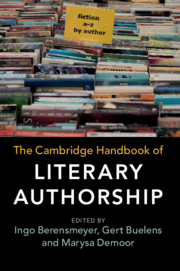Book contents
- The Cambridge Handbook of Literary Authorship
- The Cambridge Handbook of Literary Authorship
- Copyright page
- Contents
- Figures
- Contributors
- Acknowledgments
- Abbreviations
- Chapter 1 Introduction
- Part I Historical Perspectives
- Part II Systematic Perspectives
- Part III Practical Perspectives
- Chapter 20 Attribution
- Chapter 21 Anonymity and Pseudonymity
- Chapter 22 Plagiarism and Forgery
- Chapter 23 Authorship and Scholarly Editing
- Chapter 24 Copyright and Literary Property
- Chapter 25 Censorship
- Chapter 26 Publishing and Marketing
- Chapter 27 Institutions
- Select Bibliography
- Index
Chapter 25 - Censorship
from Part III - Practical Perspectives
Published online by Cambridge University Press: 07 June 2019
- The Cambridge Handbook of Literary Authorship
- The Cambridge Handbook of Literary Authorship
- Copyright page
- Contents
- Figures
- Contributors
- Acknowledgments
- Abbreviations
- Chapter 1 Introduction
- Part I Historical Perspectives
- Part II Systematic Perspectives
- Part III Practical Perspectives
- Chapter 20 Attribution
- Chapter 21 Anonymity and Pseudonymity
- Chapter 22 Plagiarism and Forgery
- Chapter 23 Authorship and Scholarly Editing
- Chapter 24 Copyright and Literary Property
- Chapter 25 Censorship
- Chapter 26 Publishing and Marketing
- Chapter 27 Institutions
- Select Bibliography
- Index
Summary
Censorship is the suppression of speech that not everyone considers harmful. Public discourse is regulated through a multitude of mechanisms, from conventions of syntax and address, codes of civility, and professional protocols to laws against defamation, fraud, and theft of intellectual property. Michel Foucault and Pierre Bourdieu have likewise alerted us to how orthodoxies of thought may become so entrenched that they go unrecognized as controls on speech.1 For these theorists, such tacit acceptance that some speech has already been silenced represents the most insidious form of censorship. Yet their arguments neglect the most important qualitative dimension in how censorship is usually perceived, which is precisely that censorship is experienced as a prohibition. Whether it is an author stymied by state licensers or too afraid to speak plainly, a reader precluded by the church from obtaining heretical or erotic material, or a publisher threatened with violence over the dissemination of satires and caricatures, all confront censorship as a constraint on their liberty.
- Type
- Chapter
- Information
- The Cambridge Handbook of Literary Authorship , pp. 400 - 414Publisher: Cambridge University PressPrint publication year: 2019
- 1
- Cited by

